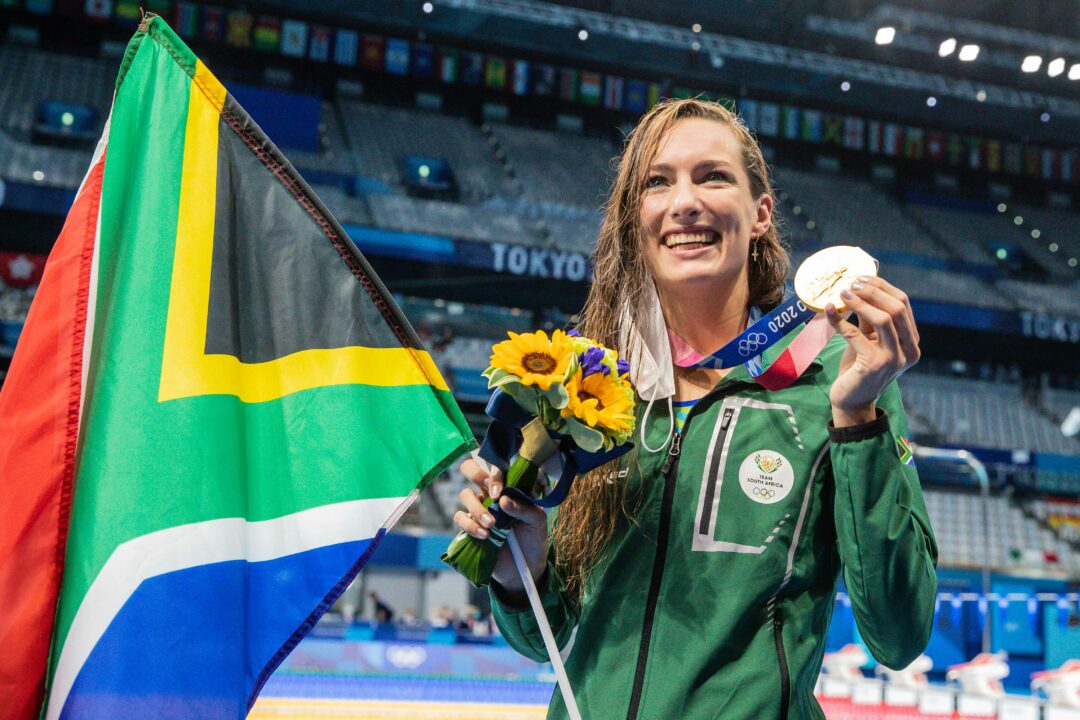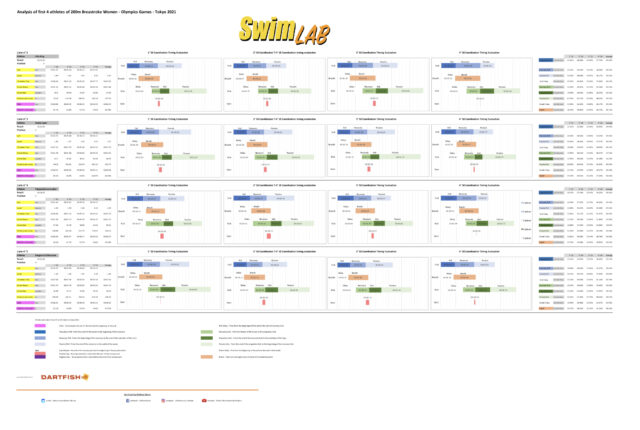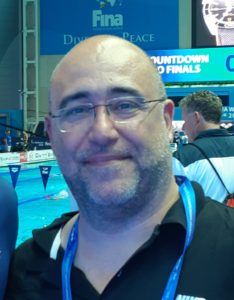Tatjana Schoenmaker docet! A new way of breathing.
At the Olympic Games in Tokyo two world records were broken in the individual races and women’s 200m breast is one of them.
Tatjana Schoenmaker set up an incredible world record with the time of 2:18.95 in the Olympic final, breaking the mark of 2:19.11 set by Rikke Pedersen at the 2013 World Championships. That breakthrough swim came after knocking on the door of the record through each of the first two rounds
In this incredible race, Lilly King started fast, leading the race until around 150 meters. But in the last 50m, Tatjana Schoenmaker tore away from the rest and reached the wall ahead of the others.
It is interesting to see that the 3rd and 4th place athletes were faster in the last 50m, but that wasn’t enough to win the race. This fits in character for both swimmers: Lazor and Chikunova have strokes built more for the closing 50 of the 200 breaststroke, and grew up as specialists in that event versus the 100 meters (though Chikunova has more lately begun to excel in 100 meters as well). King, the World Record holder over 100 meters, has always ben better in the shorter race in long course, and so her stroke and pacing is built around that strength.
Athletes splits |
1° 50m |
2° 50m |
3° 50m |
4° 50m |
Total |
| Tatjana Schoenmaker | 00:31.64 | 00:35.42 | 00:35.42 | 00:36.47 | 02:18.9 |
| Lilly King | 00:31.27 | 00:35.20 | 00:36.10 | 00:37.35 | 02:19.9 |
| Annie Lazor | 00:32.73 | 00:35.88 | 00:36.12 | 00:36.11 | 02:20.8 |
| Evgeniia Chikunova | 00:32.37 | 00:35.96 | 00:36.40 | 00:36.15 | 02:20.9 |
The kinematic analysis shows us the management of the race from a different point of view: King used a higher stroke rate (or stroke tempo if you prefer to use this parameter) and a smaller distance per stroke. Above all, after the first 25m the difference with the other swimmers was huge.
Average distance per stroke (DPS) and stroke rate (SR) |
|||||
| Athletes | 1° 50 | 2° 50 | 3° 50 | 4° 50 | |
| Schoenmaker | SR (strokes/minute) | 37.7 | 33.4 | 38.1 | 44.9 |
| DPS (CM) | 232.0 | 247.2 | 216.9 | 180.9 | |
| King | SR (strokes/minute) | 41.1 | 39.1 | 41.6 | 45.3 |
| DPS (CM) | 216.1 | 209.9 | 192.7 | 170.6 | |
| Lazor | SR (strokes/minute) | 35.6 | 34.8 | 36.1 | 40.1 |
| DPS (CM) | 234.8 | 234.8 | 224.2 | 201.7 | |
| Chikunova | SR (strokes/minute) | 35.9 | 30.8 | 32.4 | 39.3 |
| DPS (CM) | 243.3 | 260.4 | 247.6 | 205.8 | |
Checking the turns time – from 5m before the wall to 15m after the push – it is possible to see that Lilly King was faster than everyone else in the first two turns while in the last one she lost speed both absolutely and if compared to the other swimmers.
Turn Time |
Turn45-65m |
Turn95-115m |
Turn145-165m |
| Schoenmaker | 00:13.53 | 00:13.74 | 00:13.99 |
| King | 00:13.33 | 00:13.50 | 00:14.08 |
| Lazor | 00:13.85 | 00:13.82 | 00:13.78 |
| Chikunova | 00:13.60 | 00:13.86 | 00:14.03 |
It goes without saying, of course, these are small differences. The key point is to understand how Tatjana Schoenmaker was able to keep the speed until the end of the race.
COORDINATION ANALYSIS
The coordination analysis gives us a different point of view. Everybody realized that Tatjana Schoenmaker had a different kind of coordination if compared to every other swimmer. Her breathing time is absolutely different from everyone else’s in the final. Tatjana was breathing later than the others… but that’s something very easy to see in the video.
I went further: I timed every single part of the pull, the kick and the breathing and I synchronized all the movements. In this way I was able to establish the right timing of breathing. From the report it is evident that Tatjana’s breathing was not just the latest but also the fastest one: that’s something you can’t easily see watching the video in real time!
The report shows all these data in the charts and in the resume tables on the right of the charts, along with the breathing time and the delay of the breathing at the beginning of the stroke. Moreover, to better understand the value of these data, they have been expressed even as percentages.
CLICK HERE FOR THE PDF ANALYSIS
HERE FOR THE COORDINATION PDF ANALYSIS
The new way of breathing
We can see that Tatjana was the only one to start breathing during the recovery portion of the pull. This technical trick is not something new but it may be the key of Schoenmaker’s swimming. Not a lot of swimmers are able to swim in this way and when they do, it is only with a slow stroke rate/tempo. When the stroke rate/tempo gets faster, it is more difficult to perform a late breath. Tatjana Schoenmaker can do that in an amazing way.
Thanks to the late breath, the athlete can pull in a completely horizontal body position, and in this way, they can use a high percentage of the applied strength to move the body forward, wasting just a small percentage of the same strength. We can see the synch between pull and breath in the charts.
All other athletes started breathing before the end of the pull action and, in this way, they inclined the body during last part of the pull, losing some of that propulsion in the process.
It’s no more a secret that the swimming technique is connected to the stroke rate: that means that it is possible to adopt different technical “tricks” for different strokes rate/tempo. When the stroke rate/tempo is slow, the kick follows the arms recovery in order to establish a horizontal body position during the kick itself. In this way the friction force is reduced as much as possible, and the body moves forward easier. When the stroke rate/tempo gets faster this solution is not efficient enough for several reasons (click here to read the “Adam Peaty secret”).
THE SCHOENMAKER’S SECRET
The new world record holder Tatjana Schoenmaker can keep a late breath for long, as we have already described, but… that’s not all! Thanks to her short time breathing, she can also kick when the body is again horizontal. The second point of this strategy is used also by other swimmers.
At this point you can think that the Olympic Champion’s secret the has been revealed… but, on a careful analysis of the data we can see something more which is very interesting and reflects the great job she and her coach Rocco Meiring did.
The management of the kick action
The management of the kick action shows a precise evolution during the race.
If we check the evolution of the propulsive kick time for every single athlete, we can see that these values change during the race.
Lilly King was quite regular in the first three 50m, with a slight increase in times: in the last 50m the increase was greater.
| Lilly King | Recovery Kick | Propulsive Kick | Passive Kick |
| 1° 50m | 00:00.23 | 00:00.26 | 00:01.04 |
| 2° 50m | 00:00.30 | 00:00.28 | 00:00.95 |
| 3° 50m | 00:00.32 | 00:00.29 | 00:00.85 |
| 4° 50m | 00:00.33 | 00:00.34 | 00:00.63 |
Annie Lazor reduced that time from the second to last 50m, and the first 50m was a bit faster, probably because it was the beginning of the race.
| Annie Lazor | Recovery Kick | Propulsive Kick | Passive Kick |
| 1° 50m | 00:00.28 | 00:00.28 | 00:01.20 |
| 2° 50m | 00:00.35 | 00:00.32 | 00:01.03 |
| 3° 50m | 00:00.24 | 00:00.26 | 00:01.19 |
| 4° 50m | 00:00.31 | 00:00.23 | 00:00.97 |
Evegeniia Chikunova was very consistent, with just a very slight change.
| Evgeniia Chikunova | Recovery Kick | Propulsive Kick | Passive Kick |
| 1° 50m | 00:00.36 | 00:00.41 | 00:00.99 |
| 2° 50m | 00:00.36 | 00:00.43 | 00:01.05 |
| 3° 50m | 00:00.45 | 00:00.42 | 00:01.01 |
| 4° 50m | 00:00.36 | 00:00.43 | 00:00.76 |
Tatjana Schoenmaker kept a very regular propulsive kick time, just a bit faster in the first 50m.
| Tatjana Schoenmaker |
Recovery Kick |
Propulsive Kick |
Passive Kick |
| 1° 50m | 00:00.50 | 00:00.27 | 00:00.81 |
| 2° 50m | 00:00.51 | 00:00.31 | 00:00.92 |
| 3° 50m | 00:00.40 | 00:00.32 | 00:00.82 |
| 4° 50m | 00:00.29 | 00:00.32 | 00:00.72 |
We have already analyzed the stroke rate/tempo and we saw that there was an increase in the last 50m for all the athletes. Therefore, we can state that if they keep the same propulsive kick time and speed up the stroke rate/tempo, they can spare time in other parts of the same kick.
Lilly King showed us something interesting in the last 50m but she might have been tired and unfortunately, that was not so good! She slowed down both the propulsive kick time and the recovery kick and shortened the passive/glide kick. At same time she increased the stroke rate/tempo: we can easily understand that in this way it was impossible to kick efficiently.
CONCLUSION
Schoenmaker’s solution is the most interesting and efficient: she kept the time of the propulsive kick unchanged; she reduced the recovery kick and kept the passive/gliding kick: in this way she did not have to change the mechanic of the kick and of the gliding when she increased her stroke rate.
The breaststroke coordination is connected to the stroke rate/tempo, to the speed, and to the distance per stroke. When these parameters change, the coordination changes.
The 200m breast Women at Olympic Games gave us the possibility to speak about this style, to appreciate four amazing swimmers and to analyze some different techniques. Thanks athletes, thank you Tatjana Schoenmaker and, of course, thanks a lot Rocco Meiring!
This story comes from STEFANO NURRA
- Analyst of Turkish Swimming Federation
- Analyst of Energy Standard
- Owner and Founder of Swim Lab
- [email protected]



amazing article and I’d be amazed if I understood it, and if I understood breastsroke
This is not new.
Calm down mac
Great analysis! Well done.
Buss down, breathe late 😍😍
Very informative and insightful article. Great work Thank you!
Is she going to become this generation’s Barrowman? Only time will tell…
If she goes 2:10 I’ll eat my paper suit.
Has anyone done a life check on Willswim, the last guy to declare he would eat swimming gear?